SKODA SUPERB 2009 2.G / (B6/3T) Owner's Manual
Manufacturer: SKODA, Model Year: 2009, Model line: SUPERB, Model: SKODA SUPERB 2009 2.G / (B6/3T)Pages: 294, PDF Size: 21.33 MB
Page 231 of 294
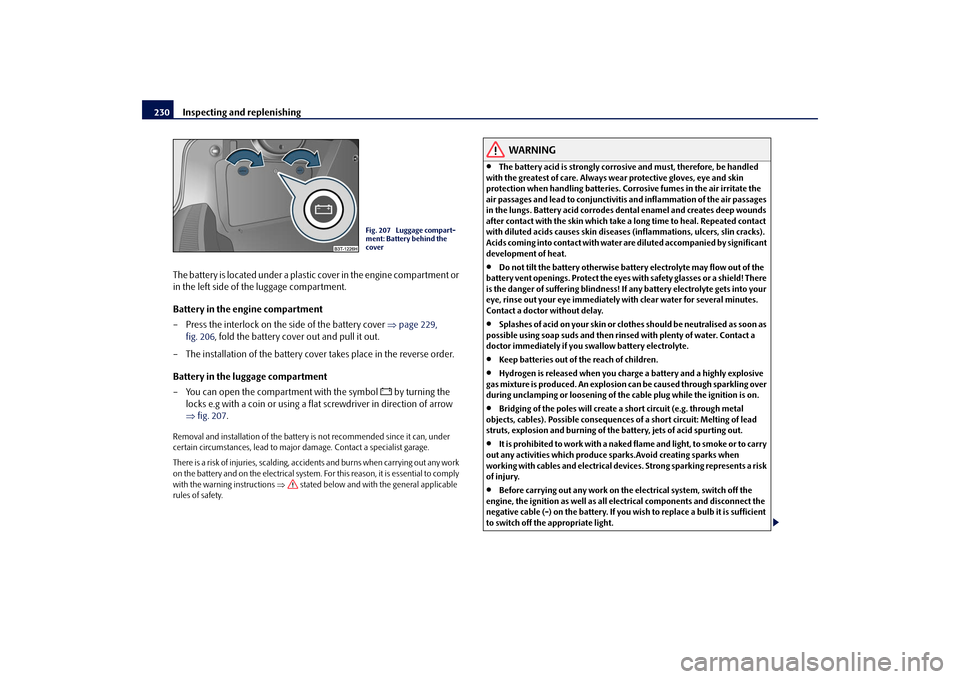
Inspecting and replenishing
230
The battery is located under a plastic cover in the engine compartment or in the left side of the luggage compartment. Battery in the engine compartment – Press the interlock on the side of the battery cover
⇒
page 229,
fig. 206
, fold the battery cover out and pull it out.
– The installation of the battery co
ver takes place in the reverse order.
Battery in the luggage compartment – You can open the compartment with the symbol
by turning the
locks e.g with a coin or using a flat screwdriver in direction of arrow ⇒
fig. 207
.
Removal and installation of the battery
is not recommended since it can, under
certain circumstances, le
ad to major damage. Contact a specialist garage.
There is a risk of injuries, scalding, acci
dents and burns when carrying out any work
on the battery and on the electrical system.
For this reason, it is essential to comply
with the warning instructions
⇒
stated below and with the general applicable
rules of safety.
WARNING
•
The battery acid is strongly corros
ive and must, therefore, be handled
with the greatest of care. Always we
ar protective gloves, eye and skin
protection when handling batteries. Corrosive fumes in the air irritate the air passages and lead to conjunctivitis and inflammation of the air passages in the lungs. Battery acid corrodes dental enamel and creates deep wounds after contact with the skin which take a long time to heal. Repeated contact with diluted acids causes skin diseases (inflammations, ulcers, slin cracks). Acids coming into contact with water are diluted accompanied by significant development of heat.•
Do not tilt the battery otherwise battery electrolyte may flow out of the
battery vent openings. Protect the eyes
with safety glasses or a shield! There
is the danger of suffering blindness!
If any battery electr
olyte gets into your
eye, rinse out your eye immediately
with clear water for several minutes.
Contact a doctor without delay.•
Splashes of acid on your skin or clothes should be neutralised as soon as
possible using soap suds and then rinsed with plenty of water. Contact a doctor immediately if you
swallow batter
y electrolyte.
•
Keep batteries out of the reach of children.
•
Hydrogen is released when you char
ge a battery and a highly explosive
gas mixture is produced. An explosion
can be caused through sparkling over
during unclamping or loosening of the
cable plug while the ignition is on.
•
Bridging of the poles will create a short circuit (e.g. through metal
objects, cables). Possible consequences of a short circuit: Melting of lead struts, explosion and burning of the battery, jets of acid spurting out.•
It is prohibited to work with a naked
flame and light, to smoke or to carry
out any activities which produce sparks.Avoid creating sparks when working with cables and electrical device
s. Strong sparking represents a risk
of injury.•
Before carrying out any work on the electrical system, switch off the
engine, the ignition as well as all el
ectrical components and disconnect the
negative cable (-) on the battery. If you wish to replace a bulb it is sufficient to switch off the appropriate light.
Fig. 207 Luggage compart- ment: Battery behind the cover
s2dk.1.book Page 230 Wednesday, April 8, 2009 12:23 PM
Page 232 of 294

Inspecting and replenishing
231
Using the system
Safety
Driving Tips
General Maintenance
Breakdown assistance
Technical Data
•
Never charge a frozen or thawed battery - risk of explosion and caustic
burns! Replace a frozen battery.•
Never jump-start the batteries which
have a too low electrolyte level -
risk of explosion and caustic burns!•
Never use a battery which is damaged
- risk of explosion! Immediately
replace a damaged battery.
Caution
•
You must only disconnect the battery if
the ignition is switched off, otherwise
the electrical system (electronic compon
ents) of the vehicle may be damaged.
When disconnecting the battery from the electrical system of the vehicle, first disconnect the negative terminal (-) of
the battery. Then disconnect the positive
terminal (+).•
When reconnecting the battery, first conn
ect the positive terminal (+) and only
then the negative terminal (-) of the ba
ttery. You must on no account connect the
cables wrongly - risk of a cable fire.•
Ensure that battery acid does not come
into contact with the vehicle body
otherwise damage could occur to the paintwork.•
Do not place the battery in direct dayl
ight in order to protect the battery
housing from the effects of ultra-violet light.
For the sake of the environment
A removed battery is a special type of waste which is harmful to the environment - contact your specialist garage regarding disposing of the battery.
Note
Please also refer to the guidelines
⇒page 233, also after connecting the battery.
Battery with two-tone indicatorAn indicator for the electrolyte level, the so-called magic eye
⇒fig. 208
, is located
on the top of the battery. The indicator change
s its colour in line with the electrolyte
level in the battery. Air bubbles can influence the colour of the
indicator. For this reason carefully knock
on the indicator before carrying out the check.•
Black colour - electrolyte level is correct.
•
Colourless or light yellow colour - electr
olyte level too low, the battery must be
replaced. Batteries, which are more than 5 years old, must be replaced. We recommend you have the battery checked or repl
aced by a specialist garage.
Caution
If the vehicle has not been driven for more than 3 to 4 weeks, the battery will discharge because certain electrical components consume electricity (e.g. control units) also in idle state. You can prevent the discharging of the battery by discon- necting the negative terminal or charging
the battery constant
ly with a very low
charging current. Please also refer to
the notes when working on the battery
⇒ page 229, “Working on the battery”.
WARNING (continued)
Fig. 208 The battery: magic eye
s2dk.1.book Page 231 Wednesday, April 8, 2009 12:23 PM
Page 233 of 294

Inspecting and replenishing
232
Note
•
Batteries with two-tone indicator, which are mounted as of factory, are marked
with a code which always begins with
5K0
. The exact marking can be e.g.
5K0 915 105 D
.
•
Replacement batteries with two-tone in
dicator, which were obtained from
Škoda original accessories,
are marked with the code
000 915 105 Dx
, whereby
“x” stands for a variable. The exact marking can be e.g.
000 915 105 DB
.
Battery with three-tone indicatorAn indicator for the electrolyte level and
the charge state, the so-called magic eye
⇒ page 231, fig. 208
, is located on the top of the ba
ttery. The indicator changes its
colour in line with the charge state and the electrolyte level in the battery. Air bubbles can influence the colour of the
indicator. For this reason carefully knock
on the indicator before
carrying out the check.
•
Green colour - the battery is adequately charged.
•
Dark colour - the battery has to be charged
•
Colourless or yellow colour - electrolyte level too low, the battery must be
replaced. Batteries, which are more than 5 years old, must be replaced. We recommend you have the battery checked or repl
aced by a specialist garage.
Caution
If the vehicle has not been driven for more than 3 to 4 weeks, the battery will discharge because certain electrical comp
onents consume electricity (e.g. control
units) also in idle state. You can prevent
the discharging of the battery by discon-
necting the negative terminal or charging
the battery constantly with a very low
charging current. Please also refer to
the notes when working on the battery
⇒ page 229.
Note
•
Batteries with three-tone indicator, which are mounted as of factory, are
marked with a code which always begins with
1J0
, 7N0
or 3B0
. The exact marking
can be e.g.
1J0 915 105 AC
.
•
Replacement batteries with three-tone
indicator, which were obtained from
Škoda original accessories, are marked with the code
000 915 105 Ax
, whereby
“x” stands for a variable. The exact marking can be e.g.
000 915 105 AB
.
Inspecting the electrolyte levelThe battery is practically
maintenance-free
under normal operating conditions.
We do, however, recommend that you have
the electrolyte level inspected from
time to time by a specialist garage when outside temperatures are high or when driving on long trips. You should also have the electrolyte level
⇒page 233
checked each time the battery is charged. The electrolyte level of the battery will al
so be checked as part of the Inspection
Service.Operation in winterThe battery has to provide greater amounts of electricity during the winter. It also has only part of the initial power output at
low temperatures that it has at normal
temperatures. A discharged battery may already freez
e at temperatures just below 0°C.
We therefore recommend that you have
the battery checked by an authorised
Škoda Service Partner before the start of the winter and recharged if necessary.
WARNING
Never charge a frozen or thawed battery - risk of explosion and caustic burns. Replace a frozen battery.
s2dk.1.book Page 232 Wednesday, April 8, 2009 12:23 PM
Page 234 of 294

Inspecting and replenishing
233
Using the system
Safety
Driving Tips
General Maintenance
Breakdown assistance
Technical Data
Charging the battery A properly charged battery is essential for reliably starting the engine.–Read the warning notes
⇒
in “Working on the battery” on
page 229 and
⇒
.
– Switch the ignition and all
electrical components off.
– Only for “quick-charging”: Disconnect
both battery cables (first of all
“negative”, then “positive”).
– Carefully attach the terminal clam
ps of the charger to the battery
terminals (red = “positive”, black = “negative”).
– You can now plug the mains cable of the charger into the power socket
and switch on the charger.
– When charging is completed: switch the charger off and unplug the
mains cable from the power socket.
– Only then should you disconnect the terminal clamps of the charger.– Reconnect the cables to the battery
(first of all “positive”, then “nega-
tive”).
It is not normally necessary
to disconnect the cables of the battery if you recharge
the battery using low ampera
ges (as for example from a
mini-charger
). Please also
refer to the instructions from the charger manufacturer. A charging current of 0.1 of the total batter
y capacity (or lower) is that which should
be used until full charging is achieved. It is, however, necessary to disconnect both
cables before charging the battery with
high amperages, so-called “
quick-charging
”.
“Quick-charging” a battery is
dangerous
⇒
in “Working on the battery” on
page 229. It requires a special charger and appropriate knowledge. We therefore re c o m m e n d t h a t y o u h a v e y o u r b a t t e r y q u i c k - c h a rg e d o n l y b y a n a u t h o ri s e d Š ko d a Service Partner.
A discharged battery may already
freeze
at temperatures just below 0°C
⇒
. We
recommend that you no longer use a ba
ttery which has thawed out because the
casing of the battery may be cracked through the formation of ice and this would allow battery electrolyte to flow out. The vent plugs of the battery shou
ld not be opened for charging.
WARNING
Never charge a frozen or thawed battery - risk of explosion and caustic burns. Replace a frozen battery.Disconnecting and reconnecting the batteryOn disconnecting and reconnecting the battery the following functions are initially deactivated or are no longer able to operate fault-free. We recommend having the vehicle checked by an authorised Škoda Service Partner to ensure full functionality of all electrical systems.Replacing the batteryYou should only replace a battery with a
new battery of the same capacity, voltage
(12 V), amperage and of the same size. The authorised Škoda Service Partners have a range of suitable batteries available. We recommend that you only have an old
battery disposed of by an authorised
Škoda Service Partner since it does require special disposal.Operation
Operating measure
Electrical power window
(operational faults)
⇒page 56
Enter radio code number
see Radio Operating Instructions
Set hours
⇒page 21
Data in the multi-functional indicator* are deleted.
⇒ page 21
s2dk.1.book Page 233 Wednesday, April 8, 2009 12:23 PM
Page 235 of 294
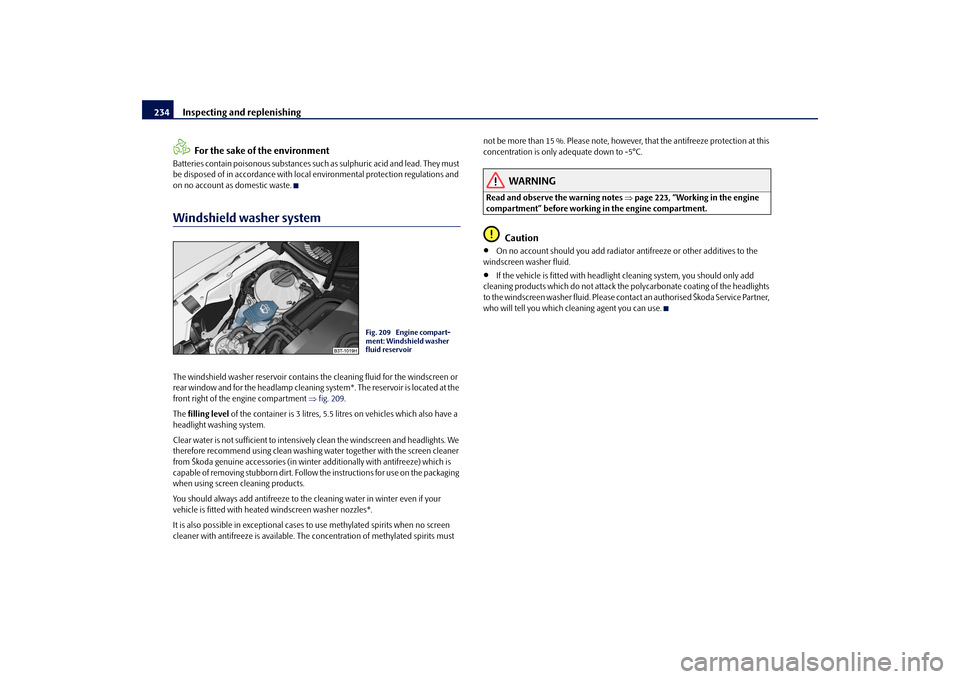
Inspecting and replenishing
234
For the sake of the environment
Batteries contain poisonous substances such as sulphuric acid and lead. They must be disposed of in accordance with local environmental protection regulations and on no account as domestic waste.Windshield washer systemThe windshield washer reservoir contains
the cleaning fluid for the windscreen or
rear window and for the headlamp cleaning
system*. The reservoir is located at the
front right of the engine compartment
⇒fig. 209
.
The
filling level
of the container is 3 litres, 5.5 li
tres on vehicles which also have a
headlight washing system. Clear water is not sufficient to intensivel
y clean the windscreen
and headlights. We
therefore recommend using clean washing wa
ter together with the screen cleaner
from Škoda genuine accessorie
s (in winter additionally with antifreeze) which is
capable of removing stubborn dirt. Follow
the instructions for use on the packaging
when using screen cleaning products. You should always add antifreeze to the
cleaning water in wi
nter even if your
vehicle is fitted with heated windscreen washer nozzles*. It is also possible in exceptional cases to use methylated spirits when no screen cleaner with antifreeze is
available. The concentration
of methylated spirits must
not be more than 15 %. Please note, however, that the antifreeze protection at this concentration is only adequate down to -5°C.
WARNING
Read and observe the warning notes
⇒page 223, “Working in the engine
compartment” before working in the engine compartment.
Caution
•
On no account should you add radiator
antifreeze or other additives to the
windscreen washer fluid.•
If the vehicle is fitted with headlight
cleaning system, you should only add
cleaning products which do not attack th
e polycarbonate coating of the headlights
to the windscreen washer fluid. Please contact an authorised Škoda Service Partner, who will tell you which cleaning agent you can use.
Fig. 209 Engine compart- ment: Windshield washer fluid reservoir
s2dk.1.book Page 234 Wednesday, April 8, 2009 12:23 PM
Page 236 of 294
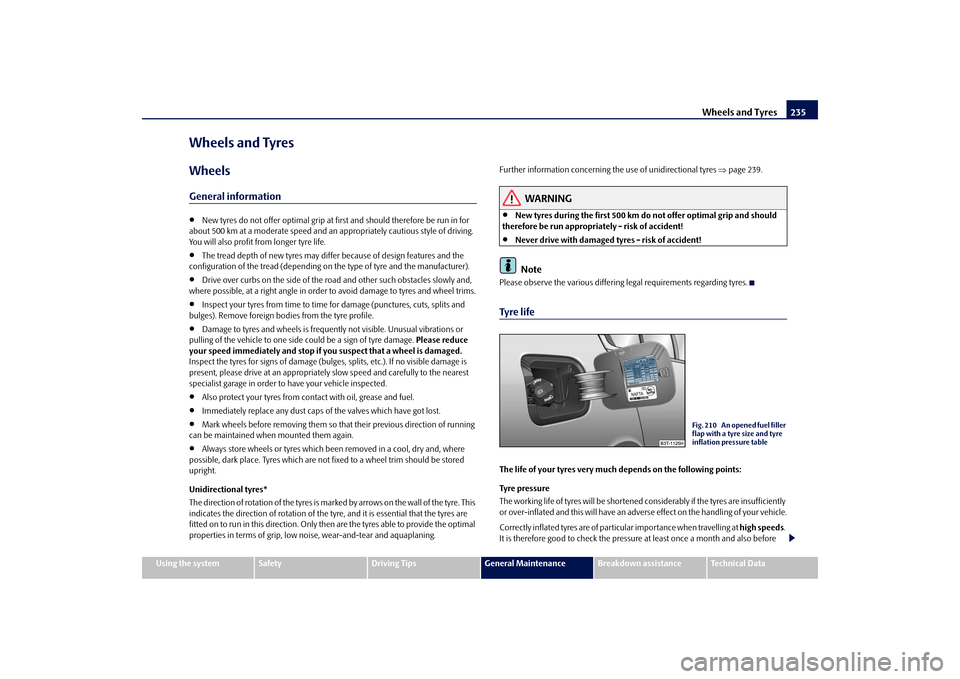
Wheels and Tyres
235
Using the system
Safety
Driving Tips
General Maintenance
Breakdown assistance
Technical Data
Wheels and TyresWheelsGeneral information•
New tyres do not offer optimal grip at first and should therefore be run in for
about 500 km at a moderate speed and an
appropriately cautious style of driving.
You will also profit from longer tyre life.•
The tread depth of new tyres may differ
because of design features and the
configuration of the tread (depending on
the type of tyre and the manufacturer).
•
Drive over curbs on the side of the road
and other such obstacles slowly and,
where possible, at a right angle in order to avoid damage to tyres and wheel trims.•
Inspect your tyres from time to time
for damage (punctures, cuts, splits and
bulges). Remove foreign bodies from the tyre profile.•
Damage to tyres and wheels is frequent
ly not visible. Unus
ual vibrations or
pulling of the vehicle to one side
could be a sign of tyre damage.
Please reduce
your speed immediately and stop if
you suspect that a wheel is damaged.
Inspect the tyres for signs of damage (bulges,
splits, etc.). If no
visible damage is
present, please drive at an appropriatel
y slow speed and carefully to the nearest
specialist garage in order to have your vehicle inspected.•
Also protect your tyres from contact with oil, grease and fuel.
•
Immediately replace any dust caps of the valves which have got lost.
•
Mark wheels before removing them so th
at their previous direction of running
can be maintained when mounted them again.•
Always store wheels or tyres which been removed in a cool, dry and, where
possible, dark place. Tyres which are not fixed to a wheel trim should be stored upright. Unidirectional tyres* The direction of rotation of the tyres is marked by arrows on the wall of the tyre. This indicates the direction of rotation of the tyre, and it is essential that the tyres are fitted on to run in this direction. Only then
are the tyres able to provide the optimal
properties in terms of grip, low noise, wear-and-tear and aquaplaning.
Further information concerning
the use of unidi
rectional tyres
⇒page 239.
WARNING
•
New tyres during the first 500 km do not offer optimal grip and should
therefore be run appropriately - risk of accident!•
Never drive with damaged tyres - risk of accident!Note
Please observe the various differing legal requirements regarding tyres.Tyre lifeThe life of your tyres very much depends on the following points: Tyre pressure The working life of tyres will be shortened considerably if the tyres are insufficiently or over-inflated and this will have an advers
e effect on the handli
ng of your vehicle.
Correctly inflated tyres are of partic
ular importance when travelling at
high speeds
.
It is therefore good to check the pressure at least once a month and also before
Fig. 210 An opened fuel filler flap with a tyre size and tyre inflation pressure table
s2dk.1.book Page 235 Wednesday, April 8, 2009 12:23 PM
Page 237 of 294
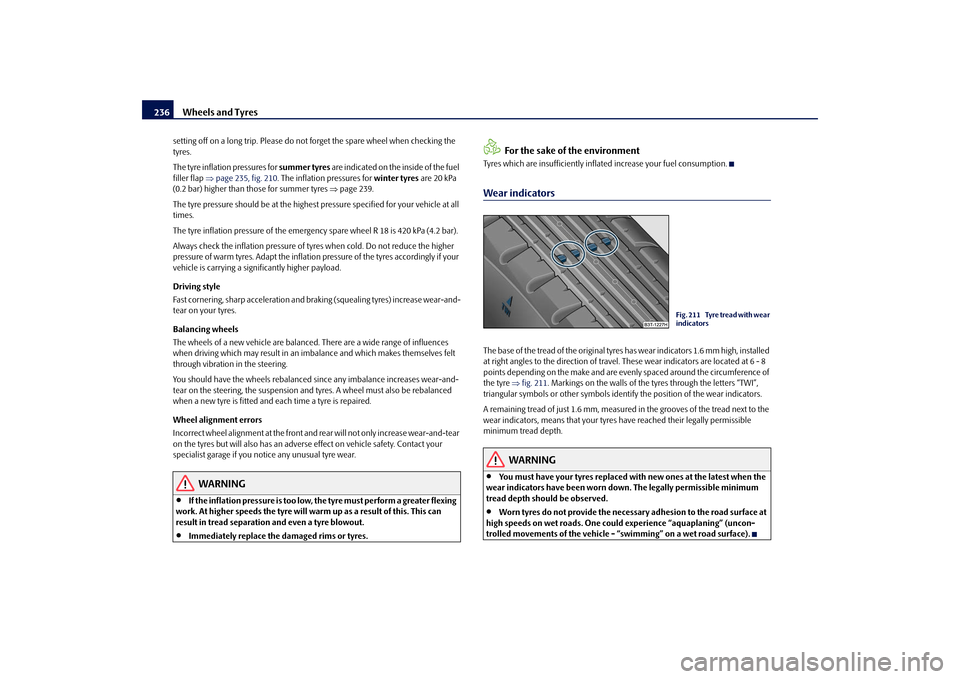
Wheels and Tyres
236
setting off on a long trip. Please do not forget the spare wheel when checking the tyres. The tyre inflation pressures for
summer tyres
are indicated on the inside of the fuel
filler flap
⇒page 235, fig. 210
. The inflation pressures for
winter tyres
are 20 kPa
(0.2 bar) higher than those for summer tyres
⇒page 239.
The tyre pressure should be at the highest pressure specified for your vehicle at all times. The tyre inflation pressure of the emergency spare wheel R 18 is 420 kPa (4.2 bar).Always check the inflation pressure of ty
res when cold. Do not reduce the higher
pressure of warm tyres. Adapt the inflation pressure of the tyres accordingly if your vehicle is carrying a significantly higher payload. Driving style Fast cornering, sharp acceleration and braking (squealing tyres) increase wear-and- tear on your tyres. Balancing wheels The wheels of a new vehicle are balanced. There are a wide range of influences when driving which may result in an imbalance and which makes themselves felt through vibration in the steering. You should have the wheels rebalanced
since any imbalance increases wear-and-
tear on the steering, the suspension and
tyres. A wheel must also be rebalanced
when a new tyre is fitted and each time a tyre is repaired. Wheel alignment errors Incorrect wheel alignment at the front and re
ar will not only increase wear-and-tear
on the tyres but will also has an adverse
effect on vehicle safety. Contact your
specialist garage if you notice any unusual tyre wear.
WARNING
•
If the inflation pressure is too low,
the tyre must perform a greater flexing
work. At higher speeds the tyre will warm up as a result of this. This can result in tread separation and even a tyre blowout.•
Immediately replace the damaged rims or tyres.
For the sake of the environment
Tyres which are insufficiently inflated increase your fuel consumption.Wear indicatorsThe base of the tread of the original tyres has wear indicators 1.6 mm high, installed at right angles to the direction of travel. These wear indicators are located at 6 - 8 points depending on the make and are evenly spaced around the circumference of the tyre
⇒fig. 211
. Markings on the walls of the
tyres through the letters “TWI”,
triangular symbols or other symbols identi
fy the position of the wear indicators.
A remaining tread of just 1.6 mm, measured in the grooves of the tread next to the wear indicators, means that your tyres
have reached their legally permissible
minimum tread depth.
WARNING
•
You must have your tyres replaced with new ones at the latest when the
wear indicators have been worn do
wn. The legally permissible minimum
tread depth should be observed.•
Worn tyres do not provide the necessar
y adhesion to the road surface at
high speeds on wet roads. One coul
d experience “aquaplaning” (uncon-
trolled movements of the vehicle - “swimming” on a wet road surface).
Fig. 211 Tyre tread with wear indicators
s2dk.1.book Page 236 Wednesday, April 8, 2009 12:23 PM
Page 238 of 294

Wheels and Tyres
237
Using the system
Safety
Driving Tips
General Maintenance
Breakdown assistance
Technical Data
Changing wheels aroundIf significantly greater wear is present on the front tyres, we recommend changing the front wheels around with the rear wheels as shown in the diagram
⇒fig. 212
.
You will then obtain approximately the same life for all the tyres. It may be advantageous to swap the tyre
s over “crosswise” when certain types of
wear characteristic arise on
the running surface of the tyres (but not in the case of
unidirectional tyres). The co-workers of the authorised Škoda Service Partners are extensively familiar with the combination possibilites. We recommend that you change the wheels around every 10 000 km in order to achieve even wear on all wheels and to obtain optimal tyre life.New tyres and wheelsTyres and wheel rims are important design
elements. One should therefore use the
tyres and wheel rims which have been released for use by Škoda Auto. They are exactly matched to the vehicle type and th
erefore contribute significantly to good
road holding and safe driving characteristics
⇒
.
Only fit radial tyres of the same type on
all 4 wheels, size (rolling circumference)
and, if possible, the same tread pattern on one axle. The authorised Škoda Service Partners have access to the most current information about which tyres we have rele
ased for use on your vehicle.
We recommend that you have any work rela
ting to tyres or wheels carried out by
an authorised Škoda Service Partner
. The authorised Škoda Service Partners
have all of the necessary special tools
and replacement parts available plus the
required specialist knowledge and are also in a position to properly dispose of the old tyres. A large number of authorised Škod
a Service Partners also have an attrac-
tive range of tyres and wheels available. The tyre/wheel combinations which are appr
oved for your vehicle are indicated in
your vehicle documents. Approval and lice
nsing may differ according to the legis-
lation prevailing in individual countries. Proper knowledge of the tyre data makes it easier for you to select the correct type of tyre. Tyres do, for example, have the following
inscription
on their walls:
205 / 55 R 16 94 V
What this means is: The following
speed restrictions
apply to tyres.
Fig. 212 Changing wheels around
205
Tyre wid th i n m m
55
Height/width ratio in %
R
Code letter for the type of tyre -
R adial
16
Diameter of wheel in inches
94
Load index
V
Speed symbol
Speed symbol
Permissible maximum speed
S
180 km/h
T
190 km/h
H
210 km/h
V
240 km/h
W
270 km/h
Y
300 km/h
s2dk.1.book Page 237 Wednesday, April 8, 2009 12:23 PM
Page 239 of 294
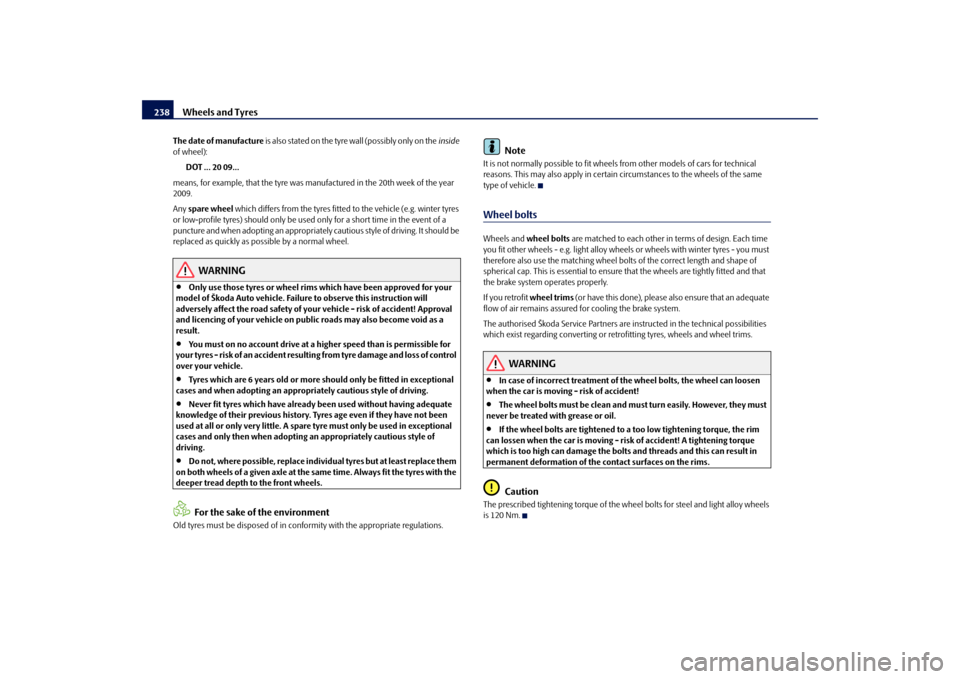
Wheels and Tyres
238
The date of manufacture
is a lso s tated on the tyre wal l (poss ibly o nl y on the
inside
of wheel):
DOT ... 20 09...
means, for example, that the tyre was manufactured in the 20th week of the year 2009. Any
spare wheel
which differs from the tyres fitted to the vehicle (e.g. winter tyres
or low-profile tyres) should only be used
only for a short time in the event of a
puncture and when adopting an appropriately
cautious style of driving. It should be
replaced as quickly as po
ssible by a normal wheel.
WARNING
•
Only use those tyres or wheel rims
which have been approved for your
model of Škoda Auto vehicle. Failure to observe this instruction will adversely affect the road safety of your vehicle - risk of accident! Approval and licencing of your vehicle on public roads may also become void as a result.•
You must on no account drive at a higher speed than is permissible for
y our t yre s - ris k of a n ac cid e n t re su lti ng fro m ty re d a m ag e a nd lo ss o f c ont rol over your vehicle.•
Tyres which are 6 years old or more should only be fitted in exceptional
cases and when adopting an appropriately cautious style of driving.•
Never fit tyres which have already been used without having adequate
knowledge of their previous history. Ty
res age even if they have not been
used at all or only very little. A spare tyre must only be used in exceptional cases and only then when adopting an appropriately cautious style of driving.•
Do not, where possible, replace indivi
dual tyres but at least replace them
on both wheels of a given axle at the same time. Always fit the tyres with the deeper tread depth to the front wheels.
For the sake of the environment
Old tyres must be disposed
of in conformity with the appropriate regulations.
Note
It is not normally possible to fit wheels
from other models of cars for technical
reasons. This may also apply in certain
circumstances to the wheels of the same
type of vehicle.Wheel boltsWheels and
wheel bolts
are matched to each other in
terms of design. Each time
you fit other wheels - e.g. light alloy wheels
or wheels with winter tyres - you must
therefore also use the matching wheel bolts of the correct length and shape of spherical cap. This is essent
ial to ensure that the wheels are tightly fitted and that
the brake system operates properly. If you retrofit
wheel trims
(or have this done), please also ensure that an adequate
flow of air remains assured for cooling the brake system. The authorised Škoda Service Partners are instructed in the technical possibilities which exist regarding converting or retrofitting tyres, wheels and wheel trims.
WARNING
•
In case of incorrect treatment of th
e wheel bolts, the
wheel can loosen
when the car is moving - risk of accident!•
The wheel bolts must be clean and must
turn easily. However, they must
never be treated with grease or oil.•
If the wheel bolts are tightened to a too low tightening torque, the rim
can lossen when the car is moving - risk of accident! A tightening torque which is too high can damage the bolts and threads and this can result in permanent deformation of the contact surfaces on the rims.
Caution
The prescribed tightening torque of the wh
eel bolts for steel and light alloy wheels
is 120 Nm.
s2dk.1.book Page 238 Wednesday, April 8, 2009 12:23 PM
Page 240 of 294
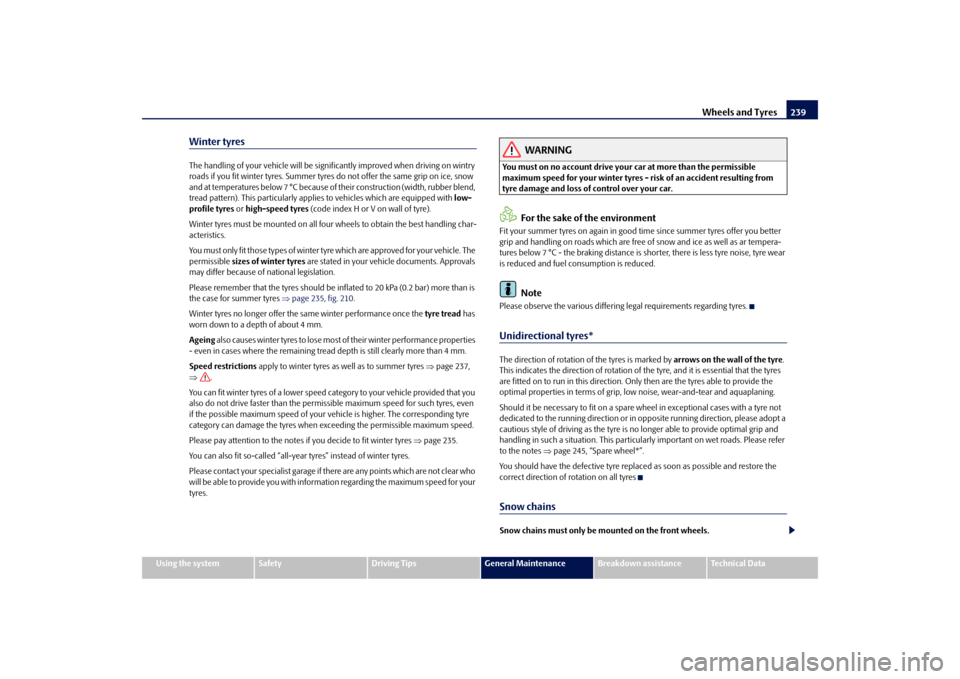
Wheels and Tyres
239
Using the system
Safety
Driving Tips
General Maintenance
Breakdown assistance
Technical Data
Winter tyresThe handling of your vehicle will be significantly improved when driving on wintry roads if you fit winter tyres. Summer tyres do not offer the same grip on ice, snow and at temperatures below 7 °C because of
their construction (width, rubber blend,
tread pattern). This partic
ularly applies to vehicles
which are equipped with
low-
profile tyres
or high-speed tyres
(code index H or V on wall of tyre).
Winter tyres must be mounted on all four wheels to obtain the best handling char- acteristics. You must only fit those types of winter tyre which are approved for your vehicle. The permissible
sizes of winter tyres
are stated in your vehicle documents. Approvals
may differ because of national legislation. Please remember that the tyres should be in
flated to 20 kPa (0.2 bar) more than is
the case for summer tyres
⇒page 235, fig. 210
.
Winter tyres no longer
offer the same winter performance once the
tyre tread
has
worn down to a depth of about 4 mm. Ageing
also causes winter tyres to lose most of their winter performance properties
- even in cases where the remaining tread depth is still clearly more than 4 mm. Speed restrictions
apply to winter tyres as well as to summer tyres
⇒page 237,
⇒
.
You can fit winter tyres of a lower speed ca
tegory to your vehicle provided that you
also do not drive faster than the permis
sible maximum speed fo
r such tyres, even
if the possible maximum speed of your ve
hicle is higher. The corresponding tyre
category can damage the tyres when ex
ceeding the permissi
ble maximum speed.
Please pay attention to the notes if
you decide to fit winter tyres
⇒page 235.
You can also fit so-called “all-year tyres” instead of winter tyres.Please contact your specialist garage if
there are any points which are not clear who
will be able to provide you with information regarding the maximum speed for your tyres.
WARNING
You must on no account drive your car at more than the permissible maximum speed for your winter tyres - risk of an accident resulting from tyre damage and loss of control over your car.
For the sake of the environment
Fit your summer tyres on again in good ti
me since summer tyres offer you better
grip and handling on roads which are free of snow and ice as well as ar tempera-tures below 7 °C - the braking distance is shorter, there is less tyre noise, tyre wear is reduced and fuel consumption is reduced.
Note
Please observe the various differing legal requirements regarding tyres.Unidirectional tyres*The direction of rotation of the tyres is marked by
arrows on the wall of the tyre
.
This indicates the direction of rotation of the tyre, and it is essential that the tyres are fitted on to run in this direction. Only then are the tyres able to provide the optimal properties in terms of grip, low noise, wear-and-tear and aquaplaning. Should it be necessary to fit on a spare
wheel in exceptional cases with a tyre not
dedicated to the running dire
ction or in opposite running
direction, please adopt a
cautious style of driving as the tyre is no
longer able to provide optimal grip and
handling in such a situation.
This particularly important
on wet roads. Please refer
to the notes
⇒page 245, “Spare wheel*”.
You should have the defective tyre replac
ed as soon as possible and restore the
correct direction of rotation on all tyresSnow chainsSnow chains must only be mounted on the front wheels.
s2dk.1.book Page 239 Wednesday, April 8, 2009 12:23 PM